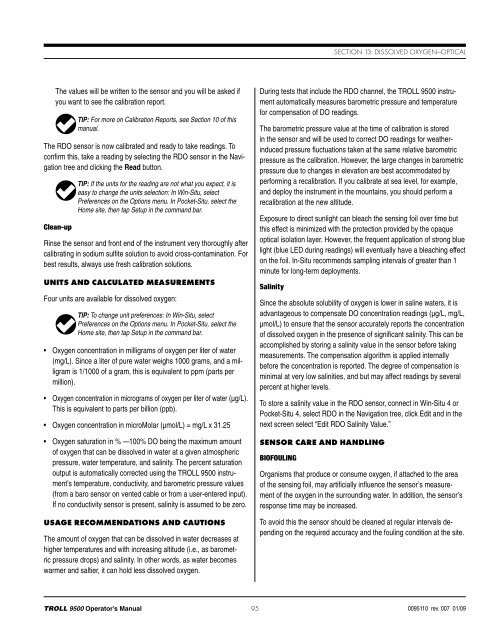TROLL 9500 Operator's Manual - Geotech Environmental Equipment
TROLL 9500 Operator's Manual - Geotech Environmental Equipment
TROLL 9500 Operator's Manual - Geotech Environmental Equipment
Create successful ePaper yourself
Turn your PDF publications into a flip-book with our unique Google optimized e-Paper software.
Section 13: Dissolved Oxygen—OpticalThe values will be written to the sensor and you will be asked ifyou want to see the calibration report.TIP: For more on Calibration Reports, see Section 10 of thismanual.The RDO sensor is now calibrated and ready to take readings. Toconfirm this, take a reading by selecting the RDO sensor in the Navigationtree and clicking the Read button.Clean-upTIP: If the units for the reading are not what you expect, it iseasy to change the units selection: In Win-Situ, selectPreferences on the Options menu. In Pocket-Situ, select theHome site, then tap Setup in the command bar.Rinse the sensor and front end of the instrument very thoroughly aftercalibrating in sodium sulfite solution to avoid cross-contamination. Forbest results, always use fresh calibration solutions.Units and Calculated MeasurementsFour units are available for dissolved oxygen:TIP: To change unit preferences: In Win-Situ, selectPreferences on the Options menu. In Pocket-Situ, select theHome site, then tap Setup in the command bar.• Oxygen concentration in milligrams of oxygen per liter of water(mg/L). Since a liter of pure water weighs 1000 grams, and a milligramis 1/1000 of a gram, this is equivalent to ppm (parts permillion).• Oxygen concentration in micrograms of oxygen per liter of water (µg/L).This is equivalent to parts per billion (ppb).• Oxygen concentration in microMolar (µmol/L) = mg/L x 31.25• Oxygen saturation in % —100% DO being the maximum amountof oxygen that can be dissolved in water at a given atmosphericpressure, water temperature, and salinity. The percent saturationoutput is automatically corrected using the <strong>TROLL</strong> <strong>9500</strong> instrument’stemperature, conductivity, and barometric pressure values(from a baro sensor on vented cable or from a user-entered input).If no conductivity sensor is present, salinity is assumed to be zero.Usage Recommendations and CautionsThe amount of oxygen that can be dissolved in water decreases athigher temperatures and with increasing altitude (i.e., as barometricpressure drops) and salinity. In other words, as water becomeswarmer and saltier, it can hold less dissolved oxygen.During tests that include the RDO channel, the <strong>TROLL</strong> <strong>9500</strong> instrumentautomatically measures barometric pressure and temperaturefor compensation of DO readings.The barometric pressure value at the time of calibration is storedin the sensor and will be used to correct DO readings for weatherinducedpressure fluctuations taken at the same relative barometricpressure as the calibration. However, the large changes in barometricpressure due to changes in elevation are best accommodated byperforming a recalibration. If you calibrate at sea level, for example,and deploy the instrument in the mountains, you should perform arecalibration at the new altitude.Exposure to direct sunlight can bleach the sensing foil over time butthis effect is minimized with the protection provided by the opaqueoptical isolation layer. However, the frequent application of strong bluelight (blue LED during readings) will eventually have a bleaching effecton the foil. In-Situ recommends sampling intervals of greater than 1minute for long-term deployments.SalinitySince the absolute solubility of oxygen is lower in saline waters, it isadvantageous to compensate DO concentration readings (μg/L, mg/L,μmol/L) to ensure that the sensor accurately reports the concentrationof dissolved oxygen in the presence of significant salinity. This can beaccomplished by storing a salinity value in the sensor before takingmeasurements. The compensation algorithm is applied internallybefore the concentration is reported. The degree of compensation isminimal at very low salinities, and but may affect readings by severalpercent at higher levels.To store a salinity value in the RDO sensor, connect in Win-Situ 4 orPocket-Situ 4, select RDO in the Navigation tree, click Edit and in thenext screen select “Edit RDO Salinity Value.”Sensor Care and HandlingBiofoulingOrganisms that produce or consume oxygen, if attached to the areaof the sensing foil, may artificially influence the sensor’s measurementof the oxygen in the surrounding water. In addition, the sensor’sresponse time may be increased.To avoid this the sensor should be cleaned at regular intervals dependingon the required accuracy and the fouling condition at the site.<strong>TROLL</strong> <strong>9500</strong> Operator’s <strong>Manual</strong> <strong>9500</strong>95110 rev. 007 01/09
















